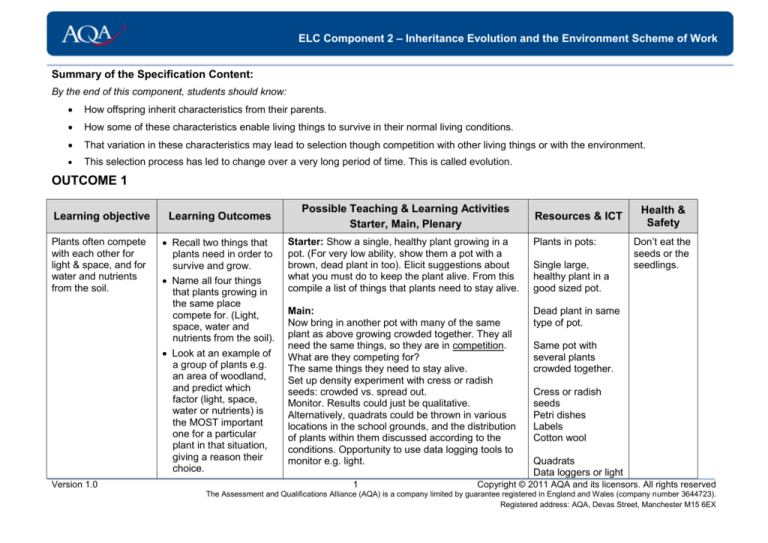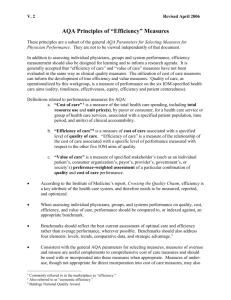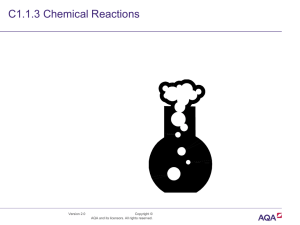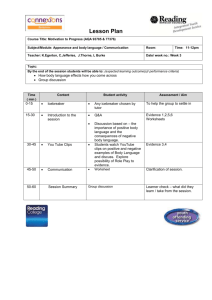
ELC Component 2 – Inheritance Evolution and the Environment Scheme of Work
Summary of the Specification Content:
By the end of this component, students should know:
How offspring inherit characteristics from their parents.
How some of these characteristics enable living things to survive in their normal living conditions.
That variation in these characteristics may lead to selection though competition with other living things or with the environment.
This selection process has led to change over a very long period of time. This is called evolution.
OUTCOME 1
Learning objective
Learning Outcomes
Plants often compete
with each other for
light & space, and for
water and nutrients
from the soil.
Recall two things that
plants need in order to
survive and grow.
Name all four things
that plants growing in
the same place
compete for. (Light,
space, water and
nutrients from the soil).
Look at an example of
a group of plants e.g.
an area of woodland,
and predict which
factor (light, space,
water or nutrients) is
the MOST important
one for a particular
plant in that situation,
giving a reason their
choice.
Version 1.0
Possible Teaching & Learning Activities
Starter, Main, Plenary
Resources & ICT
Starter: Show a single, healthy plant growing in a
pot. (For very low ability, show them a pot with a
brown, dead plant in too). Elicit suggestions about
what you must do to keep the plant alive. From this
compile a list of things that plants need to stay alive.
Plants in pots:
Main:
Now bring in another pot with many of the same
plant as above growing crowded together. They all
need the same things, so they are in competition.
What are they competing for?
The same things they need to stay alive.
Set up density experiment with cress or radish
seeds: crowded vs. spread out.
Monitor. Results could just be qualitative.
Alternatively, quadrats could be thrown in various
locations in the school grounds, and the distribution
of plants within them discussed according to the
conditions. Opportunity to use data logging tools to
monitor e.g. light.
Dead plant in same
type of pot.
1
Single large,
healthy plant in a
good sized pot.
Health &
Safety
Don’t eat the
seeds or the
seedlings.
Same pot with
several plants
crowded together.
Cress or radish
seeds
Petri dishes
Labels
Cotton wool
Quadrats
Data loggers or light
Copyright © 2011 AQA and its licensors. All rights reserved
The Assessment and Qualifications Alliance (AQA) is a company limited by guarantee registered in England and Wales (company number 3644723).
Registered address: AQA, Devas Street, Manchester M15 6EX
ELC Component 2 – Inheritance Evolution and the Environment Scheme of Work
Plenary:
Show images of plants growing in the wild – a
succession of pictures of a woodland in winter,
spring & summer. Discuss the changing conditions
(environmental factors) and how this affects the plant
distribution. NB bluebells flowering before the
canopy develops.
Video clips on:
http://www.youtube.com/watch?v=1lRJ1xdpDMU&fe
ature=related
&
http://www.youtube.com/watch?v=QSvCVuuS2uk
Version 1.0
2
meters.
Writing frame.
Video clips.
Copyright © 2011 AQA and its licensors. All rights reserved
The Assessment and Qualifications Alliance (AQA) is a company limited by guarantee registered in England and Wales (company number 3644723).
Registered address: AQA, Devas Street, Manchester M15 6EX
ELC Component 2 – Inheritance Evolution and the Environment Scheme of Work
OUTCOME 2
Learning objective
Animals often
compete with each
other for food, mates
and territory.
Learning Outcomes
Recall two things that
animals need to
survive.
Name all three things
which animals compete
for. (Food, mates and
territory).
Look at an example of
a group of animals and
say what they are
competing for, and
explain which is the
main factor. E.g. a food
plant covered in
caterpillars, two male
deer fighting, and a
rock covered in sea
birds with their nests.
Could extend to:
What makes a successful
competitor?
Version 1.0
Possible Teaching & Learning Activities
Starter, Main, Plenary
Starter:
Care of a pet. Show pictures or actual animal.
Discuss how you would care for that pet. Also what
would happen if you introduced more animals to its
housing?
Elicit list of what animals compete for in the wild.
Main:
Complete a writing frame with some pictorial
examples on demonstrating the three main factors
for competition.
Opportunity to set up a woodlice choice chamber
(colour of background or damp area), but with limited
space for the woodlice to go. Or maggots could be
used competing for shelter from light.
Less able could do a storyboard or table (3 columns
with factor in the middle; domestic animal in first
column & wild equivalent in third column) about
caring for a pet e.g. a rabbit, and compare this to a
wild rabbit searching for the same things to stay
alive.
Plenary:
Show pictures of scenarios or video clips e.g. Animal
fights on:
http://www.youtube.com/watch?v=ntztz8ggMwM&fea
ture=fvwrel
Elicit which main factor is being competed for.
Factors could be written on the board and students
vote.
3
Resources & ICT
Health &
Safety
Writing frame(s)
Woodlice
Petri dishes or
choice chambers
Dark paper/ filter
paper & water
Timers
Or maggots
Desk lamp
Choice chambers or
Petri dishes.
Timers
Video clips &
pictures.
Copyright © 2011 AQA and its licensors. All rights reserved
The Assessment and Qualifications Alliance (AQA) is a company limited by guarantee registered in England and Wales (company number 3644723).
Registered address: AQA, Devas Street, Manchester M15 6EX
ELC Component 2 – Inheritance Evolution and the Environment Scheme of Work
OUTCOME 3
Learning objective
Learning Outcomes
Animals and plants
may be adapted for
survival in the
conditions where they
normally live.
Correctly identify one
adaptation for an
animal that lives in an
extreme environment.
eg a named adaptation
of a polar bear or
cactus plant.
Correctly identify an
adaptation for extreme
cold and an adaptation
for extreme heat or
drought on at least one
organism for each
environment. Explain in
simple terms how this
benefits the each
organism’s survival.
Apply knowledge and
understanding of
adaptations to an
‘unknown’ organism,
given information about
where it lives.
Conversely, student
could guess what type
of habitat, environment
or conditions it lives in
by looking at its
adaptations.
Version 1.0
Possible Teaching & Learning Activities
Starter, Main, Plenary
Starter:
Look at a picture/ video clip of a hot, dry desert.
What are the ‘conditions in such an environment?
What would an animal or plant need to be able to do
in order to survive here?
Video clip of Sahara desert photo montage on:
http://www.youtube.com/watch?v=lcdeBxkjqLg&featu
re=related
Clip long and dramatic enough to have playing whilst
students enter room.
Main:
Select desert animals from a ‘line-up’ of photos.
Include a camel.
Focus on camel as example for Sahara desert.
Elicit adaptations with explanations.
Play this video clip (The Adaptation Song) on:
http://www.youtube.com/watch?v=YX8VQIJVpTg
Also:
http://www.bbc.co.uk/learningzone/clips/how-is-acamel-adapted-to-live-in-the-desert/6563.html
Resources & ICT
Pictures &/or video
clips of hot & cold
dry deserts
Pictures of animals
& plants adapted to
these conditions,
with a few
organisms which do
not display the
adaptations.
Health &
Safety
Animals and
plants may
be adapted
for survival in
the
conditions
where they
normally live.
Writing frames &
pictures to label.
Equipment for
cooling experiment
if carried out.
Students to label large picture of camel with as many
adaptations as they can remember. Can differentiate
this greatly.
Focus on cacti.
Show students a selection of cacti plants – what
have they got in common? Show next to a
conventional plant like a geranium. Do they have the
4
Copyright © 2011 AQA and its licensors. All rights reserved
The Assessment and Qualifications Alliance (AQA) is a company limited by guarantee registered in England and Wales (company number 3644723).
Registered address: AQA, Devas Street, Manchester M15 6EX
ELC Component 2 – Inheritance Evolution and the Environment Scheme of Work
same features?
How are they different in a cactus? Why?
Could watch So Darwin – which plants store water in
the desert? Not very age appropriate – but the
students might just buy it if you warn them – contains
good information:
http://www.youtube.com/watch?v=4F4HKfvr7woor
http://www.bbc.co.uk/learningzone/clips/how-cactisurvive-in-the-dry-desert/66.html
Complete labelling on picture of a ‘typical’ cactus.
Repeat all scenarios for extreme cold conditions
using Polar bears as example.
BBC clip of mother & cubs emerging from den on:
http://www.youtube.com/watch?v=OwZH_aT0FGI
Could extend with an experiment on rate of cooling &
colour of body covering or huddling.
Plenary:
Students spot desert or arctic animals from a line-up
or sorting exercise. Use pictures. More able students
can justify choices rather than just ‘know’ which are
which.
Could also do a dominoes game with pictures and
adaptation matching.
Version 1.0
5
Copyright © 2011 AQA and its licensors. All rights reserved
The Assessment and Qualifications Alliance (AQA) is a company limited by guarantee registered in England and Wales (company number 3644723).
Registered address: AQA, Devas Street, Manchester M15 6EX
ELC Component 2 – Inheritance Evolution and the Environment Scheme of Work
OUTCOME 4
Learning
objective
Learning
Outcomes
Possible Teaching & Learning Activities
Starter, Main, Plenary
Animals and
plants are
subjected to
environmental
changes.
Name one way in
which the
environment
changes.
Name one living
and one non-living
factor for
environmental
change.
Go on to explain
the impact of that
change on a named
organism.
Starter:
Show a changing seasons video clip such as:
http://www.youtube.com/watch?v=fRsl5Fp6GVk
or a clip about migration such as:
http://www.youtube.com/watch?v=hOJiSkj02mE&feature=fvsr
Elicit from whole class what changes could occur throughout the
year in a particular location. Sort into plant, animal and non-living
changes.
May touch upon natural and man-made changes depending upon
what class comes up with.
Look at predator/prey relationships on:
http://www.bbc.co.uk/learningzone/clips/population-size-andcontrol-predators-and-prey/5499.html
Such changes
may be caused
by living or
non-living
factors.
Main:
Look at the case of the honeybee. Watch:
http://www.bbc.co.uk/learningzone/clips/ecology-of-the-oneybee/7187.html
Use a writing frame to record the environmental factors which
affect the bees and how the decline in bees affects other living
things.
Can extend this topic to measure the change in environmental
factors such as temperature/rainfall over a day/week.
Can also extend topic by carrying out an activity such as pond
dipping, and monitoring which animals prefer to live in which
locations – what factor is limiting their distribution?
Resources & ICT
Health
&
Safety
Video clips or a sequence of
seasonal pictures for
starter.
Writing frames for recording
work.
Video clip of honey bee
from BBC website.
Equipment for measuring
environmental factors such
as max/min temperature
thermometers and rainfall
gauges or data loggers.
Pond dipping apparatus and
trays in which to examine
catch. Magnifying lenses
and identification sheets.
Pictures showing changes
brought about by man for
plenary.
Plenary:
Version 1.0
6
Copyright © 2011 AQA and its licensors. All rights reserved
The Assessment and Qualifications Alliance (AQA) is a company limited by guarantee registered in England and Wales (company number 3644723).
Registered address: AQA, Devas Street, Manchester M15 6EX
ELC Component 2 – Inheritance Evolution and the Environment Scheme of Work
Show a picture of man’s impact on the environment such as the
clearing of a habitat such as rainforest for agriculture. Discuss the
impact on the natural species. e.g. orang-utans.
OUTCOME 5
Learning
objective
Learning
Outcomes
Possible Teaching & Learning Activities
Starter, Main, Plenary
Radiation from
the Sun is the
source of
energy for
living
organisms.
Recall that the Sun
is needed for there
to be life on Earth.
Recall that the
process which
changes light
energy into
chemical energy
(food) is called
photosynthesis.
This happens in
green plants.
Be able to write or
complete a word
equation for
photosynthesis and
go on to say what
the energy-rich
product sugar can
go on to make and
be stored as other
substances.
Starter:
Use the nice, healthy green plant from a few lessons ago and ask
what would happen to it if we gave it plenty of water and warmth,
but shut it in a cupboard.
Elicit that light is necessary for it to survive.
What does it do with that light?
Green plants
and algae
absorb a small
amount of the
light that
reaches them.
The transfer
from light
energy to
chemical
energy occurs
during
photosynthesis
.
This energy is
stored in the
substances
that make up
Version 1.0
Main:
Practical opportunity. Testing leaves for starch from plants which
have been treated in a variety of ways: no light/stencil patch to
give the effect of light/no light.
Need to discuss the relationship between sugar & starch.
Also test variegated leaves which have a pattern with no
chlorophyll.
Establish that light and chlorophyll are both needed for the plant
to make food (change light into chemical energy).
Students record onto a writing frame.
Go on to discuss what else the plants can make besides starch.
Plenary:
Show a slide of some algae – is this a plant? Where does it live?
Can it photosynthesise? Why is it important?
All life depends upon plants?
7
Resources & ICT
Health &
Safety
Healthy green plant.
Healthy plants such as
geraniums which have been
kept in full light conditions.
If students are to investigate
the effect of light
themselves, then foil to
cover the leaves, or this can
already have been set up
for 2 or more days on some
of the leaves – or another
plant kept in a completely
dark cupboard.
Flammable
liquid
Hot
apparatus
and
Bunsen
flames.
Variegated variety of the
same plant.
Copyright © 2011 AQA and its licensors. All rights reserved
The Assessment and Qualifications Alliance (AQA) is a company limited by guarantee registered in England and Wales (company number 3644723).
Registered address: AQA, Devas Street, Manchester M15 6EX
ELC Component 2 – Inheritance Evolution and the Environment Scheme of Work
the cells of the
plants.
Is this statement true?
Summed up nicely on the BBC clip:
http://www.bbc.co.uk/learningzone/clips/the-products-ofphotosynthesis/10606.html
Carbon dioxide
+ water
sugar + oxygen
Boiling tubes, beakers,
methylated spirits,
Iodine, white tile, pipettes.
OUTCOME 6
Learning
objective
Learning
Outcomes
Possible Teaching & Learning Activities
Starter, Main, Plenary
Living things
remove
materials from
the
environment
for growth &
other
processes.
These
materials are
returned to the
environment
either in waste
materials or
when living
things die &
decay.
To recall that when
living things die and
decay, that the
materials they are
made from pass
back into the
environment.
State that the
organisms which
cause decay are
microorganisms.
Describe conditions
in which
microorganisms
make decay
happen the fastest.
Starter:
Show time lapse of decaying fruit on:
http://www.bbc.co.uk/learningzone/clips/decaying-fruit/862.html
or could show a plate of real decayed fruit.
What has happened?
Elicit the conditions for decay to happen. Might bring in same food
stored in a fridge to prompt.
Main:
Set up an investigation to show what causes decay of bread or
fruit to happen fastest. Could be an element of competition here.
Students to plan where to put their food sample and why this
would cause it to decay. How best to set it up so that the food has
all of the conditions for fast decay.
Students record their set up and results on writing frames.
Why did the winner win?
Materials
decay because
they are
broken down
(digested) by
Version 1.0
Resources & ICT
Video clip / pictures or
rotted fruit.
Dishes to put food on.
Writing frames for recording
observations.
Dried fruit in a jar, frozen
food packet,
tinned fruit or bottled fruit.
8
Biohazard.
Do not
handle
decayed
fruit.
Fruit & bread for
experiment.
Water.
Plenary:
Look at some stored food e.g. dried fruit / frozen food / tinned or
bottled food – why does that not decay?
Health &
Safety
Do not eat
food
samples or
handle
food once
rotted.
Safe
Copyright © 2011 AQA and its licensors. All rights reserved
The Assessment and Qualifications Alliance (AQA) is a company limited by guarantee registered in England and Wales (company number 3644723).
Registered address: AQA, Devas Street, Manchester M15 6EX
ELC Component 2 – Inheritance Evolution and the Environment Scheme of Work
microorganism
s.
Microorganism
s are more
active & digest
materials faster
in warm, moist,
aerobic
conditions.
Version 1.0
disposal of
rotted
food.
9
Copyright © 2011 AQA and its licensors. All rights reserved
The Assessment and Qualifications Alliance (AQA) is a company limited by guarantee registered in England and Wales (company number 3644723).
Registered address: AQA, Devas Street, Manchester M15 6EX
ELC Component 2 – Inheritance Evolution and the Environment Scheme of Work
OUTCOME 7
Learning
objective
Learning
Outcomes
Possible Teaching & Learning Activities
Starter, Main, Plenary
The nucleus of
a cell contains
chromosomes.
Can identify the
nucleus in a cell.
State that it controls
the cell.
State that the
nucleus contains
our genes which
control what we
look like.
State that the
genes are found on
structures called
chromosomes.
Name a
characteristic
controlled by our
genes.
Starter:
Montage of cell diagrams. Spot the nucleus. Recall that a nucleus
controls the cell.
Chromosomes
carry genes
that control the
characteristics
of the body.
Resources & ICT
Health &
Safety
Main:
Use microscopes or bioviewers to look at cell slides. Could recap
on making onion skin 7 cheek cell slides from Yr7. Draw and label
nucleus.
Look at prepared slides showing chromosomes.
This clip shows mitosis, which is not required at EL, but it shows
chromosomes well, and can be played with the sound track off.
http://www.bbc.co.uk/learningzone/clips/cell-division-bymitosis/4189.html
This clip: Genetics 1 : Part 1 What are genes? On:
http://www.youtube.com/watch?v=eOvMNOMRRm8
is more detailed than EL requires again, but it explains the overall
message very well.
Sequence the words: cell, nucleus, chromosome, gene in the
correct order for size. Could illustrate on a writing frame once
sequenced.
Plenary:
Repeat identification of nucleus from starter. Identify
chromosomes from a picture. Recall that they are made up of
Version 1.0
10
Copyright © 2011 AQA and its licensors. All rights reserved
The Assessment and Qualifications Alliance (AQA) is a company limited by guarantee registered in England and Wales (company number 3644723).
Registered address: AQA, Devas Street, Manchester M15 6EX
ELC Component 2 – Inheritance Evolution and the Environment Scheme of Work
genes.
OUTCOME 8
Learning
objective
Learning
Outcomes
Possible Teaching & Learning Activities
Starter, Main, Plenary
The
information that
results in
plants and
animals having
similar
characteristics
to their parents
is carried by
genes, which
are passed in
the sex cells
from which the
offspring
develop.
State that you look
like your parents
because they have
passed their genes
on to you.
State that these
characteristics are
passed on from
parents in their sex
cells which then go
on to make
offspring.
That offspring have
genes from both
parents, so they are
similar but different
to each parent.
Each offspring will
have its own
combination of
characteristics.
Offspring show
variation.
Starter:
Look at Sharon & Karen on this clip from the BBC Learning Zone:
http://www.bbc.co.uk/learningzone/clips/twins-similarities-anddifferences/2481.html
Or
Look at a photograph of a family. Do the children look like their
parents? Have they inherited the same characteristics, or do they
show variation?
Sexual
reproduction
involves the
joining of male
and female sex
cells. The
mixture of
genetic
information
from two
parents leading
to variety in the
offspring.
Version 1.0
Main:
This clip Genetics 101 Part 3: Where do your genes come from?
http://www.youtube.com/watch?v=lJzZ7p-47P8&feature=related
is again more detailed than EL requires, but it is very accessible,
and does raise the main teaching & learning points required.
A more basic, general explanation of fertilisation can be seen on
this clip from the BBC:
http://www.bbc.co.uk/learningzone/clips/an-introduction-tofertilisation/116.html
Students could label an outline of a human to show was in which
variation can be expressed on different features.
A class survey could be carried out of various features (e.g. finger
length/hand span, height, hair or eye colour tongue rolling), and
data processed according to the ability of the group.
Plenary:
Show students pictures of variation in other species. Elicit
characteristics according to images used.
11
Resources & ICT
Video clips
or photograph of a family
group.
Health &
Safety
Awareness
of family
backgrounds
of students.
Video clip
Writing frame for
recording.
Apparatus to carry out
survey.
Frames to record data
and process data if
Again,
awareness of
students who
may be
sensitive to
any of the
issues
discussed or
type of data
Copyright © 2011 AQA and its licensors. All rights reserved
The Assessment and Qualifications Alliance (AQA) is a company limited by guarantee registered in England and Wales (company number 3644723).
Registered address: AQA, Devas Street, Manchester M15 6EX
ELC Component 2 – Inheritance Evolution and the Environment Scheme of Work
required.
collected
OUTCOME 9
Learning
objective
Possible Teaching & Learning Activities
Starter, Main, Plenary
Learning
Outcomes
In asexual
Recall or
reproduction,
demonstrate how to
only one
take a cutting and
individual is
also that this is a
needed as a
way of getting new
parent. There
plants without
is no mixing of
having to grow
genetic
them from seed.
information and State that the plants
so no genetic
grown from cuttings
variation in the
all have the same
offspring.
genes and are
These
identical to the
genetically
parent plant.
identical
Explain the
individuals are
difference between
known as
the genes of a plant
clones.
grown from seed
compared to a plant
New plants are
grown from a
produced
cutting. State a
quickly and
definition of asexual
cheaply be
reproduction.
taking cuttings
from older
plants.
Version 1.0
Resources & ICT
Health &
Safety
Starter:
Show a variety of plants with asexual offspring – or pictures of
them.
e.g. spider plant with runners, strawberry plant with runners, mint
plant with suckers, ‘mother of thousands’ plant.
Show video clip about plant asexual reproduction:
http://www.youtube.com/watch?v=drcnTg7ZCoc
Main:
Taking cuttings from plants.
There are numerous ways of doing this. Mint is very reliable and
quick. The cuttings can be left to grow roots in water before
potting-up.
Students to either sequence the steps for making a cutting, or
draw a story board saying what they did – leaving a blank box to
record their results.
Students could also grow carrot or pineapple tops.
Plenary:
Consider the advantages and disadvantages of asexual
reproduction to farmers.
Could think of the implications if humans were so easily
reproduced. Could use a stimulus of a ‘cloning’ slide – showing
multiples of the same person.
12
Copyright © 2011 AQA and its licensors. All rights reserved
The Assessment and Qualifications Alliance (AQA) is a company limited by guarantee registered in England and Wales (company number 3644723).
Registered address: AQA, Devas Street, Manchester M15 6EX
ELC Component 2 – Inheritance Evolution and the Environment Scheme of Work
OUTCOME 10
Learning
objective
Learning
Outcomes
Possible Teaching & Learning Activities
Starter, Main, Plenary
Darwin’s theory
of evolution
states that all
species of
living things
have evolved
from simple
life-forms that
first developed
more than
three billion
years ago.
Recall that life on
Earth has changed
over a very long
period of time.
State that this
change is called
‘evolution,’ and that
all life on earth
began as simple
life-forms which
gradually became
more complex.
Give an example of
why fossils help to
explain evolution.
Starter:
Show this video clip:
http://www.bbc.co.uk/learningzone/clips/evolution-of-life-onearth/1833.html
And / or use a poster showing evolution as a ‘tree’ with simple life
forms at the bottom e.g.
http://library.thinkquest.org/19012/treeolif.htm
or
http://www.open2.net/treeoflife/index.html
Resources & ICT
Health &
Safety
Video clips
Tree of life poster &/or
interactive version –
access to computers for
this.
Writing frames for
recording ideas.
These diagrams can either be printed off or displayed
electronically. They are interactive. If students are accessing this
individually, they can then explore the tree.
Explain what the diagram means, and the term ‘evolution’ – the
process by which living organisms gradually change over a long
period of time. NB draw out what the branching means – which
species have common ancestors.
NB Misconception that man is the pinnacle of evolution, and that
evolution has stopped.
Main:
How do scientists know that this is what has happened?
What is the evidence?
Activity:
Examining a range of fossils and guessing what they are. Are
they alive today? Support with pictures of reconstructions.
Demo how fossils are formed and that older fossils are in lower,
older geological layers. Different collections of fossils in different
layers – they layers change as you go up. Use the Grand
Version 1.0
13
Copyright © 2011 AQA and its licensors. All rights reserved
The Assessment and Qualifications Alliance (AQA) is a company limited by guarantee registered in England and Wales (company number 3644723).
Registered address: AQA, Devas Street, Manchester M15 6EX
ELC Component 2 – Inheritance Evolution and the Environment Scheme of Work
Canyon as an example.
Students complete writing frames to record ideas, or sequencing
statements or pictures.
There is a good fossil record of the evolution of the horse which
could be used to show the change in one type of animal.
Students could make a fossil cast in modelling clay and cast in
plaster.
The work of Charles Darwin.
State Darwin’s Theory of Evolution.
Read a biographical piece about his life & work. e.g.
http://www.bbc.co.uk/history/historic_figures/darwin_charles.shtml
Or conduct own internet research.
Watch a video clip about his life:
http://www.nhm.ac.uk/nature-online/evolution/how-did-evoltheory-develop/evol-charles-darwin/index.html
Natural selection video clip:
http://www.bbc.co.uk/learningzone/clips/natural-selection-andsurvival-of-the-fittest/5516.html
Fossil collection &
pictures of
reconstructions.
Writing frame for
recording ideas.
Materials to demo
layering – plastic fish tank
or large glass beaker or
jar.
Different coloured
substrate – sand, chalk,
clay etc to make layers.
Shells & bones as
‘fossils.’
Play the evolution experience game on:
http://www.nhm.ac.uk/nature-online/evolution/what-isevolution/natural-selection-game/the-evolution-experience.html
Good free, downloadable activity by ASE upd8 on:
http://www.upd8.org.uk/activity/78/Goya-huge-hunted-andextinct.html
Writing frame / cloze exercise to record ideas.
Modelling clay, cardboard
to make rings, plaster &
equipment for mixing.
Picture of Grand Canyon.
Plenary:
Look at a stimulus picture taken from a film like One Million Years
BC showing humans fighting dinosaurs.
Version 1.0
14
Access to computer &
internet.
Care with
plaster – can
get hot when
mixed with
water –
gloves to
protect skin
Copyright © 2011 AQA and its licensors. All rights reserved
The Assessment and Qualifications Alliance (AQA) is a company limited by guarantee registered in England and Wales (company number 3644723).
Registered address: AQA, Devas Street, Manchester M15 6EX
ELC Component 2 – Inheritance Evolution and the Environment Scheme of Work
Trailer for this film on:
http://www.youtube.com/watch?v=TvkwBmfZAeo
on hands.
Writing frame
Could ancient man have lived like this? What’s the really bad
science here? (The main one - men fighting dinosaurs – they are
millions of years apart).
Version 1.0
15
Video clip or stimulus
picture.
Copyright © 2011 AQA and its licensors. All rights reserved
The Assessment and Qualifications Alliance (AQA) is a company limited by guarantee registered in England and Wales (company number 3644723).
Registered address: AQA, Devas Street, Manchester M15 6EX









